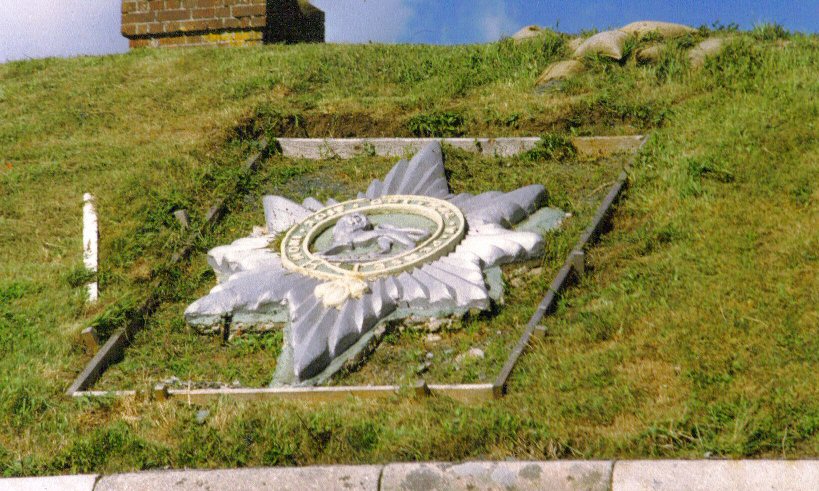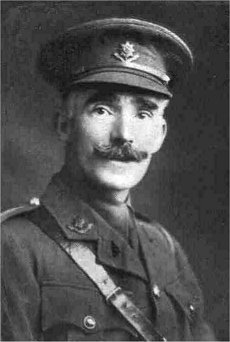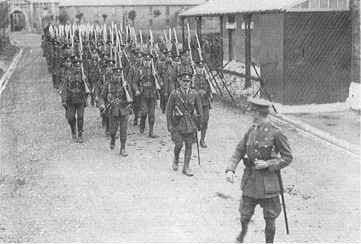5th Battalion Worcestershire Regiment - 1914 to 1919
On the outbreak of the First World War (1914) the 5th Battalion, commanded by Lieut.-Colonel W. S. Brindle, was a "Special Reserve" battalion which had been mobilized at Worcester and had proceeded to their allotted War Stations in the garrison of Plymouth (Fort Tregantle). There the half-trained ”Special Reservists“ completed their preparation for the field, and the Battalion developed into a specialised training organization, sending draft after draft abroad and receiving instead recruits of every kind. As the war continued, the ranks of the training Battalion were swelled by convalescent officers and men returned from the front, who passed varying periods at home before they were again pronounced fit for service overseas. Thus the reserve Battalion was a temporary home at one time or another for nearly all of those who passed through the ranks of the fighting Battalions; and officers and men from all Battalions met there for a few brief weeks before parting on their voyage to the different theatres of war. |
Fort Tregantle, Cornwall. Main entrance to the Keep |
Lieut.-Colonel W. S. Brindle |
Besides that ever-changing personnel, the work of the Reserve Battalion was carried out by a small nucleus of their permanent staff, reinforced by certain older officers and N.C.O’s., who could not be passed fit for service in the field. That permanent staff continued, year after year, the thankless task of training the newly-appointed subalterns and the raw recruits who came to learn the rudiments of soldiering at their hands; and to them the Regiment owes a great debt. In the winter of 1917 a partial redistribution of the forces at home was carried out, and the 5th Battalion of the Regiment were moved from Plymouth to the East Coast. There the Battalion settled down to duty in the Harwich defences, and was stationed at Manningtree and Mistley. In the following year, a reduction in strength followed the despatch of troops to France, and the 6th Battalion was temporarily amalgamated with the 5th Battalion and was commanded of Lieut.-Colonel B. R. Roche. The 5th (Reserve) Battalion (still under the temporary command of Lieut.-Colonel B. R. Roche) moved to Dublin on the 12th - 13th April, 1919 and took over quarters in Portobello Barracks. There the 5th (Reserve) Battalion had absorbed the 1st Garrison Battalion of the Regiment and had swollen thereby to a strength of nearly 2,300 of all ranks including 70 Officers. The cadre of the 5th Battalion returned to England and the Colours were laid up in Norton Barracks, and the representatives of the old Militia were demobilised. On Monday 9th July 1919, the day following the Victory March at Worcester, the Colours of the 5th Battalion, which had been laid up during the war, were handed over at Worcester Cathedral by Canon Lacey to a Colour Party sent from Dublin consisting of Captain Bishop, Lieut. G . B. Harrison, C.S.M. Charlwood, Privates Bowater and Alderthay. The same escort brought the Colours back to the Depot a fortnight later. |
On the 21st July 1919, Lieut.-Colonel H. A. Carr, D.S.O. and the Headquarters of the 2nd Battalion reached Dublin and took over the remaining personnel of the 5th Battalion.
As the 5th battalion stand to attention the Dublin Guards march in |
|

5th Battalion Worcestershire Regiment marching out of Portobello Barracks
(Major Clarke followed by Capatin Wright leading the final contigent of men out of Portobello Barracks, Dublin for the last time)

5th Battalion men (Dublin 1919)

Fort Tregantle, Cornwall Worcestershire Regimental badge on the Keep roof.




